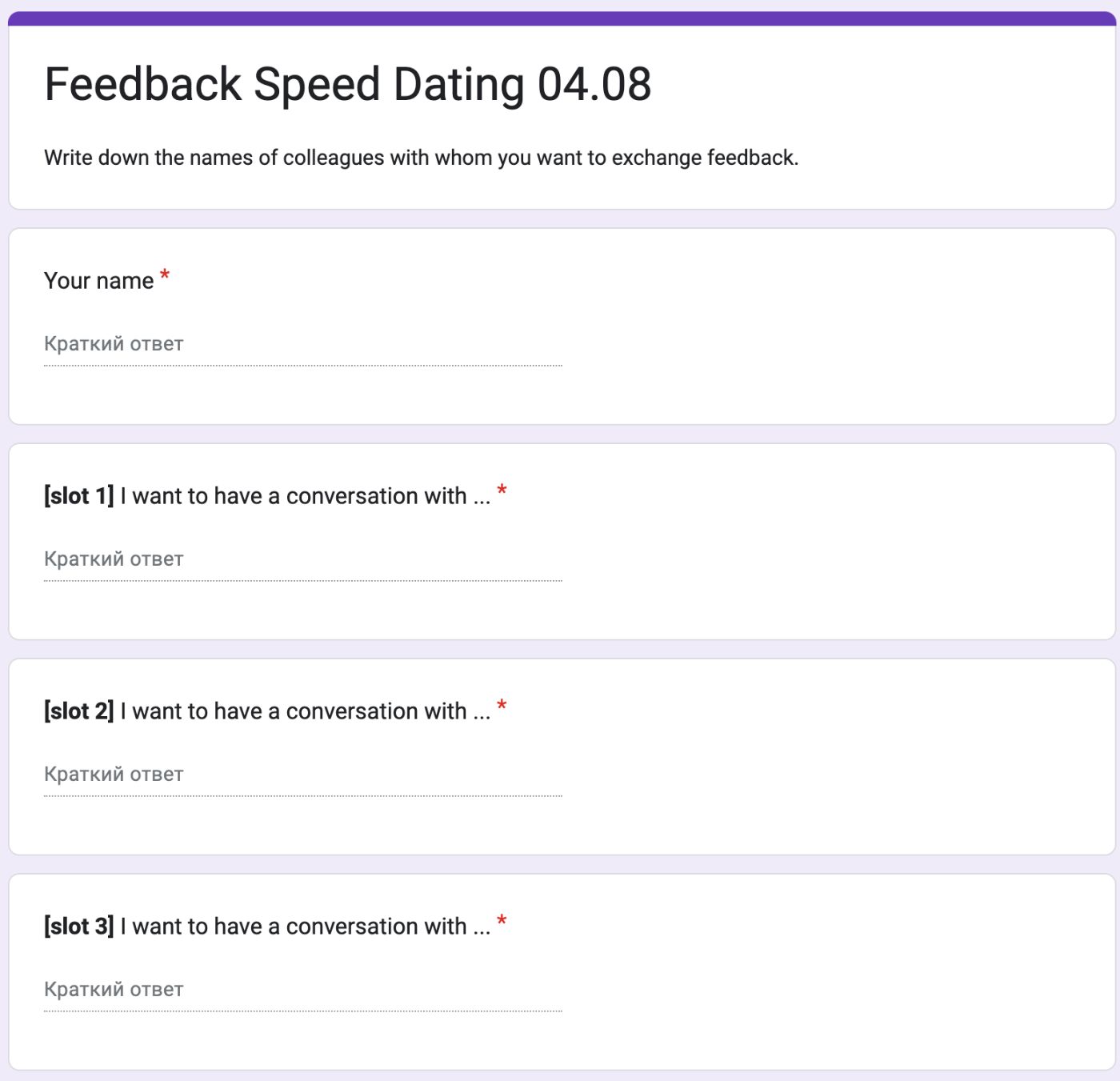and the distribution of digital products.
The Power of Feedback: Tools and Techniques for Boosting Performance
Imagine for a moment that as a leader you've invested significant effort in the professional growth of your employees, yet their performance still falls short of expectations. Timely feedback could improve the situation. But how do you give criticism without offending the person? In this article, we’ll explore how to transform feedback from a source of fear into a powerful tool for motivation and employee development.
Why Is Feedback Important?If we look at the formula for non-material motivation outlined in the previous article, we will see that more than half of the total assessment of employees' non-material motivation depends on feedback. Here are some studies that prove its importance.
\
- Gallup Research (2019)
- According to Gallup, around 65% of employees expressed a need for more frequent feedback from their leadership. However, only 19% regularly receive it. The lack of regular feedback reduces employee engagement, which in turn affects their motivation.
\
- Furthermore, the study found that employees who receive regular, constructive feedback are 3.6 times more likely to feel motivated and engaged at work.
\
- Harvard Business Review (2017)
- In a Harvard Business Review survey, 72% of employees reported that their productivity and engagement significantly improved when they received quality feedback. This underscores its importance for Non-Material motivation and overall job satisfaction.
\
- Notably, not only positive but also constructive criticism is highly valued by employees. 57% of respondents believe that constructive feedback is the most important factor in their professional development.
\
- Deloitte Research (2016)
- Deloitte's research showed that 90% of companies that implemented a system of regular feedback saw an improvement in employee performance and motivation.
\
- In companies where continuous feedback is practiced, employee engagement levels were 14% higher than in organizations where feedback is rare or inconsistent.
\
- PwC Research (2015)
- PwC found that 60% of employees from generations Y and Z prefer to receive feedback at least once a week. This emphasizes the importance of frequent feedback for motivation, especially among younger professionals, who prioritize growth and consistent support.
\ These findings confirm that feedback is a critical tool for Non-Material motivation. It fosters confidence, engagement, and improved performance of the employees. On top of that, it helps to create a more transparent and productive corporate culture.
How to Give FeedbackHowever, poor feedback can be worse than no feedback at all. Unconstructive criticism can lead to demotivation, conflicts within the team, and loss of trust between employees and leadership
\ Let’s break down how to give feedback effectively.
\ Remember, ==feedback ≠ criticism ≠ evaluation==.
\ To provide effective feedback, follow these steps:
Determine the type of feedback: motivational or corrective.
\
Decide on the appropriate setting. If it's corrective, discuss it privately with the employee. If it's motivational, you might want to give it publicly if you know it will make the person feel appreciated.
\
Stay constructive:
Focus on behavior, not the person.
Be specific: Point out specific actions or results that need improvement.
Offer solutions: Don't just criticize—propose clear steps to help the employee improve the situation.
\
- Be empathetic. Create a trustful atmosphere: Make sure the employee knows your goal is to help them grow, not to point out their shortcomings.
\ To ensure your feedback is constructive, you can also use the COIN framework:
- C – Context: Where and when the situation occurred.
- O – Observation: What the behavior looks like from an outside perspective, supported by specific numbers and facts.
- I – Impact: What the consequences of the described behavior are.
- N – Next steps: What needs to be changed? What actions should be taken and within what timeframes?
\ Be prepared that the employee might not accept criticism immediately. Even the most tactful feedback often triggers negative emotions, making it harder to digest.

\ It's generally ineffective to discuss further steps or offer support for improvement until the employee goes through all the stages of accepting feedback. At the stages of anger and resistance, any proposed help will likely be perceived negatively.
ToolsSo how do you deliver feedback effectively? Let’s focus on tools that can be used in a team setting such as during retrospectives or company events.
Speed Feedback DatingSimilar to speed dating, participants hold short meetings with different colleagues or users to receive quick, focused feedback. This method works well for teams where it’s important to gather input from multiple people in a short time. First of all, it allows employees to build trust and establish interpersonal relationships, as well as to look at the situation from different perspectives and exchange a variety of opinions.
\

Secondly, the fast pace and active interaction make the process more dynamic and interesting, helping participants stay engaged and energetic throughout the session. On top of that, this method can be used for regular team feedback exchanges as well as for special events like retrospectives or process improvement meetings.

\ Advantages of Speed Feedback Dating:
Brevity and focus: Since time for each meeting is limited, participants are forced to articulate their thoughts clearly and concisely. This helps avoid unnecessary details and focus on key points.
\
Diversity of opinions: In a short period, participants can receive feedback from several people, allowing them to see the situation from different perspectives. This helps in gaining a fuller understanding of one’s strengths and weaknesses or overall project feedback.
\
Energy and engagement: The fast pace and active interaction make the process more dynamic and interesting, helping participants stay engaged and energetic throughout the session.
\
Building trust: Unlike long, formal meetings, short one-on-one sessions allow for a more personal connection, making the feedback process less stressful.
\
Versatility: This method can be used for regular team feedback exchanges as well as for special events like retrospectives or process improvement meetings.
Each team member is tasked with gathering feedback from a specific number of colleagues. After completing the "quest," participants earn points and level up. This can be gamified into team-building activities where everyone works toward a common goal.
\ To implement this format, start by defining its purpose. It could be gathering feedback on a project, assessing skills, identifying areas of improvement, or strengthening team dynamics. It is a good idea to create a set of tasks for participants to complete while collecting feedback. For example, they can gather feedback from five colleagues on specific topics.
\ For each piece of feedback received, participants earn one point. As they accumulate points, participants can level up or receive “trophies” such as badges or certificates.
\ Advantages of Feedback Quests:
\
Gamified approach: Incorporating game elements makes the feedback process more enjoyable and less formal, encouraging more open communication.
\
Team bonding: Quests foster better collaboration among colleagues, help build new connections, and strengthen existing relationships within the team.
\
Increased engagement: Participating in activities related to feedback collection can also enhance employee engagement.
\
Enriching experience: Participants can receive diverse opinions and advice from colleagues, contributing to both professional and personal growth.
\
Focus on improvement: Such quests encourage active discussion and reflection on the received feedback, promoting continuous growth within the team.
\ Gamifying feedback is particularly suitable for companies with young, dynamic teams, as well as those open to innovative management approaches.
Appreciation MailboxA virtual or physical "mailbox" is created where employees can leave notes of gratitude or positive feedback. This helps foster an atmosphere of recognition and support.
\ Establish a regular schedule for collecting these notes (for example, weekly or monthly). This will help create a routine and maintain active employee participation.
\ You might also consider recognizing employees who receive the most notes of appreciation or introduce special awards for outstanding achievements mentioned in the notes.
\ Appreciation Mailbox helps cultivate a positive corporate culture where employees feel valued and important. It increases their engagement and job satisfaction. In addition, expressing gratitude strengthens relationships among employees, leading to better collaboration, increased trust, and mutual understanding within the team. Positive emotions triggered by gratitude and recognition can also help reduce stress levels and prevent employee burnout, especially under high workload conditions.
\ When employees feel recognized for their efforts, it can motivate them to achieve more and boost productivity. And finally, this method is easy to implement and doesn’t require significant resources. It can be applied by any team, regardless of its size or structure.
ConclusionIn this article, we’ve explored why giving feedback is crucial, touched on how to deliver it effectively, and reviewed some creative team methods that not only provide feedback but also foster team unity through gamification.
\ However, ==two critical points== stand out for any leader when giving feedback:
- ==Empathy==
- ==Consistency==
\ Adapt to your employees’ emotional state, try to understand the situation before passing your judgment, and give them a chance to explain their point of view. Keep in mind that actions require consistency. So, to boost Non-Material motivation, employees need to know they will receive regular feedback on their work. All in all, as they say, “There is no failure, only feedback.”
- Home
- About Us
- Write For Us / Submit Content
- Advertising And Affiliates
- Feeds And Syndication
- Contact Us
- Login
- Privacy
All Rights Reserved. Copyright , Central Coast Communications, Inc.